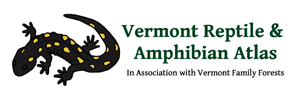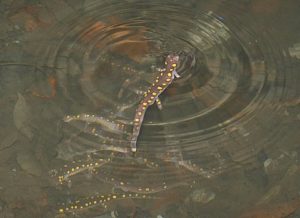Ambystoma maculatum
Identification 
The Spotted Salamander is the largest of Vermont’s three mole salamanders. It grows up to 9 inches long. It is a black salamander with bright yellow spots. Spotted Salamanders have strong legs and a broad flat head.
They spend most of the year underground in shrew, mole, or mouse tunnels, hence the term mole salamander. They move to deeper tunnels to overwinter below the frost line.
Get more detailed identification and life history information by downloading the chart here.
You can learn more about this species and see some video footage by checking out this clip from our Rattlers, Peepers & Snappers DVD.
Range/Habitat

[ click image to zoom | download printable PDF ]

[ click image to zoom | download printable PDF ]
Spotted Salamanders feed and overwinter in upland hardwood and mixed forests. They breed in vernal pools, beaver ponds, or old farm ponds. The Spotted Salamander is found statewide.
Status
This species has a state natural heritage rank of S5 (common). The Spotted Salamander also has been designated a Species of Greatest Conservation Need (medium priority) in Vermont’s Wildlife Action Plan. Please report sightings of this species in Vermont if you have not reported them within the last five years from a given location. Any natural history observations (feeding, migrations, road crossing areas, early or late season appearance, abnormalities, etc.) are appreciated. Photographs are always helpful, particularly if your report is the first report of this species from a town.
Additional Photos
More Info
- Ambystoma maculatum at Animal Diversity website
- Ambystoma maculatum at Amphibiaweb
- Ambystoma maculatum in the Vermont Agency of Natural Resources’ Wildlife Action Plan: Amphibian & Reptiles (9/25/2015 draft)
- Ambystoma maculatum at the Yale Peabody Museum of Natural History website
Species summary written by Ariel K. McK. Burgess.
Mating Salamanders in Water
Video by Chris Fastie, copyright ©2002. Used by permission.
He writes, “About 200 spotted salamanders were in my backyard pond in Salisbury, Vermont on April 9, 2002. It was a rainy evening, but the rain had stopped so the salamanders could be seen well in the water.”






